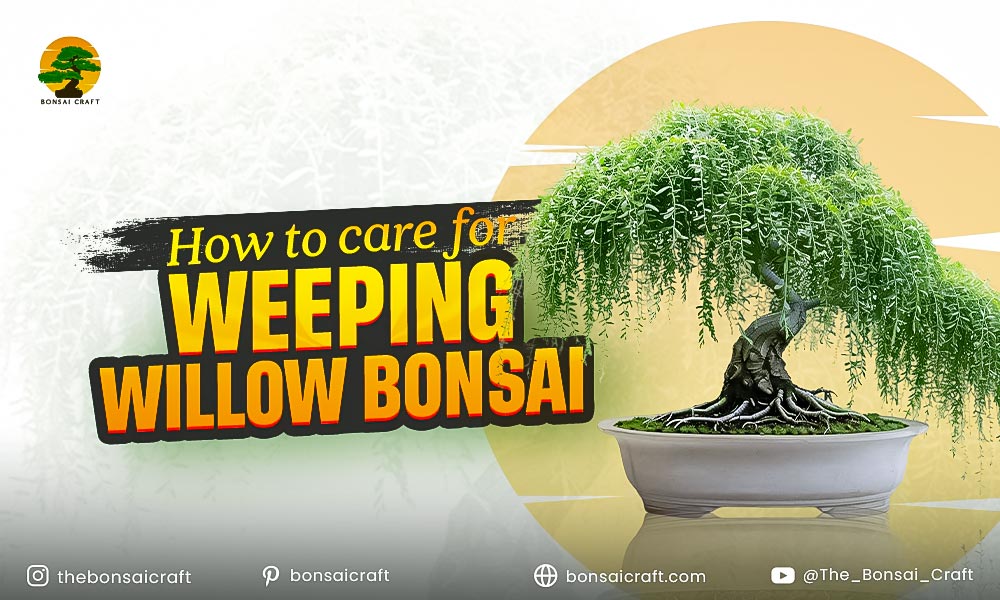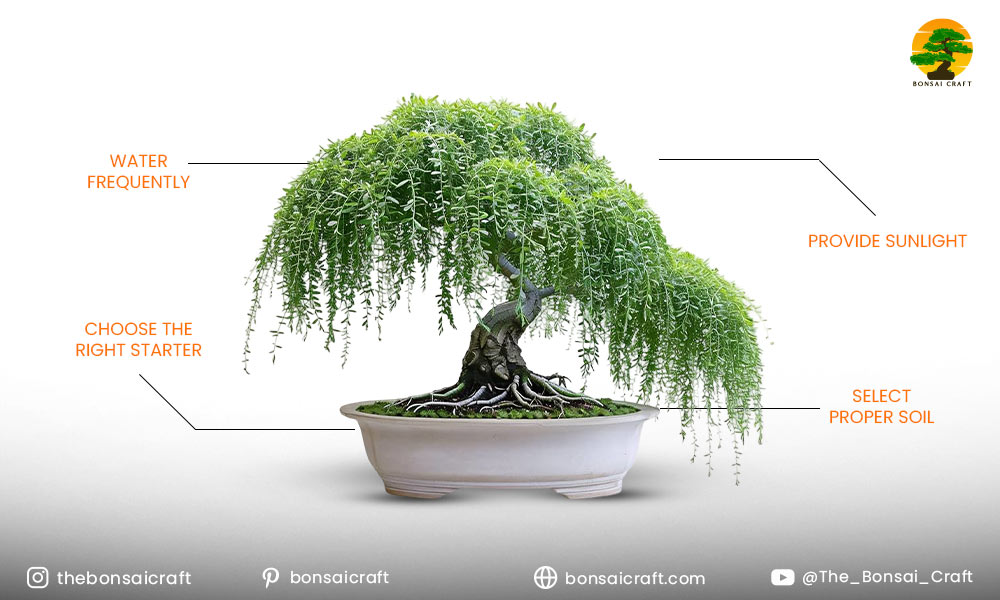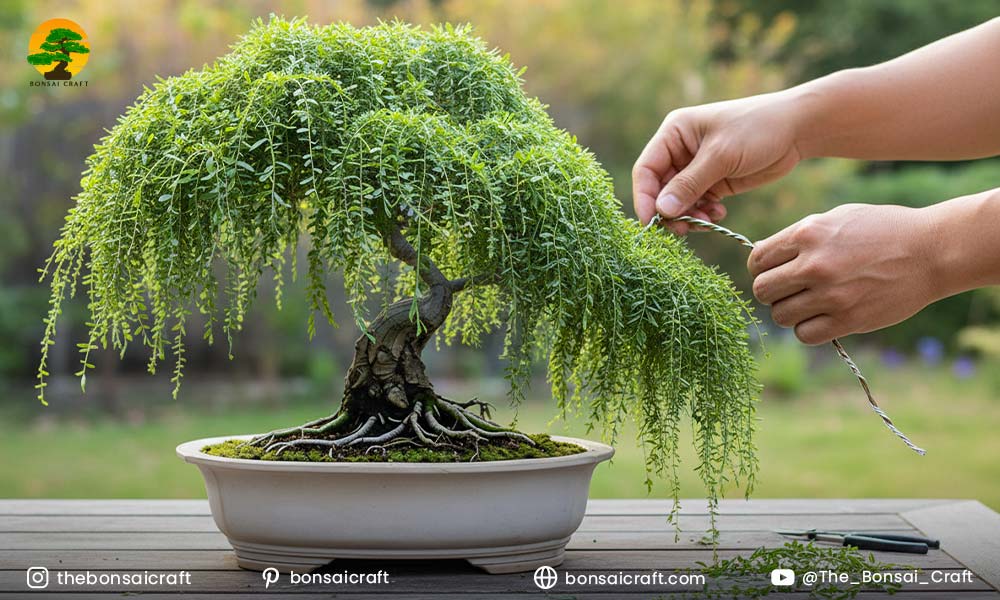
Weeping willow trees are famous for their elegant, cascading branches that sway gracefully in the wind. When transformed into a bonsai, this beauty is captured in miniature form, creating one of the most enchanting bonsai displays. However, unlike hardier bonsai species, a weeping willow bonsai tree requires special attention. Proper weeping willow bonsai care ensures healthy growth, stunning shape, and long-lasting beauty.
In this guide, I’ll share expert-level insights on how to grow a weeping willow bonsai tree, pruning, wiring, watering, and more—drawing from both horticultural research and hands-on bonsai experience.
Why Choose a Bonsai Weeping Willow Tree?
The bonsai weeping willow is an ideal choice for bonsai enthusiasts who want a dramatic, flowing appearance. Its thin, flexible branches and fast-growing nature allow for quick shaping. Unlike slower-growing bonsai, you can see results in just a few seasons.
That said, the species is sensitive—it needs more water, more pruning, and careful attention to root management. If you’re willing to dedicate time, your bonsai green weeping willow tree will reward you with unmatched elegance.

How to Grow a Weeping Willow Bonsai Tree
To grow a weeping willow bonsai tree, start from cuttings or saplings, plant in well-draining soil, and provide full sunlight with frequent watering. Shape the branches with pruning and wiring, while regularly trimming roots to control size. With patience and care, you can create a miniature willow that thrives indoors or outdoors.
Step-by-Step Growing Guide
- Choose the right starter: You can begin with seeds, cuttings, or a young nursery tree. Cuttings are preferred because they root quickly.
- Select proper soil: Use a mix of akadama, pumice, and organic compost. Willows love moisture but require drainage to prevent root rot.
- Provide sunlight: Place your bonsai tree weeping willow in full sun or partial shade. Outdoors is ideal, but an indoor weeping willow tree can grow if positioned near a bright window.
- Water frequently: Willows are thirsty trees. Keep the soil consistently moist, especially during hot months.
- Shape early: Begin light pruning in the first year to encourage the iconic cascading form.
Weeping Willow Bonsai Care Guide
Growing a bonsai weeping willow tree requires ongoing attention. Let’s break down care essentials:
Light Requirements
- Best grown outdoors in full sun.
- If indoors, ensure south-facing light or supplement with grow lights.
Watering Needs
- Daily watering in summer; soil should never fully dry.
- Consider placing your bonsai on a shallow water tray to maintain humidity.
Soil & Fertilizer
- Use moisture-retentive but airy soil.
- Apply balanced liquid fertilizer every two weeks during the growing season (spring–summer).
Temperature & Humidity
- Hardy in USDA zones 4–9.
- Indoor growth is possible if humidity is maintained at 50%+.
How to Start a Weeping Willow Bonsai
To start a weeping willow bonsai, take a cutting from a young willow branch in spring or summer, root it in moist soil, and train it as it grows. Regular watering and shaping are essential during the first year to establish a healthy miniature tree.
Willow cuttings root easily, making them beginner-friendly. Keep them in water until roots appear, then transfer to soil. Within weeks, you’ll see rapid growth.
How to Bonsai a Willow Tree
To bonsai a willow tree, select a young sapling or cutting, prune to define structure, wire branches into a cascading form, and control root growth with repotting. With proper care, the tree develops the classic weeping bonsai shape.
This process involves:
- Pruning the central leader to encourage side branches.
- Wiring young shoots downward for the weeping effect.
- Repotting every 1–2 years to prevent root binding.
How Big Do Weeping Willow Bonsai Trees Get?
A weeping willow bonsai tree typically grows between 18 and 36 inches tall, depending on pruning and pot size. With regular trimming, you can keep it small and proportional while preserving the graceful cascading branches.
Without control, willows can quickly outgrow pots, so root pruning is essential.

How to Prune Weeping Willow Bonsai
To prune a weeping willow bonsai, trim long shoots during the growing season to maintain shape, and remove dead or crossing branches in winter. Frequent pruning helps control growth and enhances the cascading effect.
Detailed tips:
- Pinch new growth every 2–3 weeks.
- Never remove all foliage at once; willows need leaves for energy.
- Focus on creating layers of branches for a natural look.

How to Wire a Weeping Willow Bonsai
To wire a weeping willow bonsai, use aluminum wire on young, flexible shoots in spring. Gently bend branches downward to mimic the natural cascade. Remove the wire within 2–3 months to prevent scarring.
Key notes:
- Only wire young branches; mature wood breaks easily.
- Combine pruning with wiring for best results.
Indoor Weeping Willow Tree Care
Growing a weeping willow bonsai indoors is possible but challenging. Willows thrive outdoors, so indoor care requires extra attention:
- Place near a south-facing window with 6+ hours of light.
- Use humidity trays or mist leaves daily.
- Avoid dry, heated rooms in winter.
For best results, rotate between indoor display and outdoor growth (spring–fall outdoors, winter indoors in harsh climates).
How to Make a Weeping Willow Bonsai Tree
To make a weeping willow bonsai tree, propagate from cuttings, plant in bonsai soil, train branches downward with wiring, and prune roots regularly. With consistent care, you can create a miniature willow with cascading elegance.
This process combines horticultural skills with artistry—shaping a fast-growing tree into a timeless display piece.
Common Problems in Weeping Willow Bonsai Care
- Root Rot: Caused by stagnant water. Prevent by using well-draining soil.
- Pests: Aphids and spider mites often target willows. Neem oil or insecticidal soap works effectively.
- Overgrowth: Willows grow aggressively—prune regularly to maintain bonsai size.
- Weak Indoors: Lack of light and humidity can weaken indoor bonsai. Consider grow lights.
Professional Tips for Bonsai Weeping Willow Success
- Always prune lightly and often—heavy pruning can stress willows.
- Combine wiring and pruning for natural cascading shapes.
- Repot every two years to refresh soil and control root spread.
- Keep multiple willows: one for practice and one for display.
Conclusion
A weeping willow bonsai tree offers breathtaking beauty with its flowing, graceful branches. While it demands more care than many bonsai species, the reward is a living sculpture that reflects patience, artistry, and dedication.
By learning how to grow a weeping willow bonsai tree, practicing careful pruning and wiring, and providing proper water and light, you can cultivate a stunning bonsai centerpiece. From my own experience, I’ve found that consistent attention—especially to watering and pruning—is the secret to success.
If you’re ready for a rewarding challenge, the bonsai weeping willow is one of the most captivating species to master.
FAQs on Weeping Willow Bonsai Care
How do you care for a weeping willow bonsai tree?
A weeping willow bonsai tree needs full sun, consistent watering, and frequent pruning. Use well-draining soil, fertilize every two weeks in the growing season, and repot every 1–2 years to maintain health.
Can a weeping willow bonsai grow indoors?
Yes, but indoor growth is difficult. An indoor weeping willow tree requires bright light, high humidity, and frequent watering. For best results, alternate between outdoor and indoor placement.
How do you prune a weeping willow bonsai?
To prune, trim long shoots every few weeks during the growing season and remove dead branches in winter. Regular pruning helps control size and encourages cascading shape in a bonsai weeping willow tree.
How long does it take to grow a weeping willow bonsai?
A bonsai green weeping willow tree grows quickly. Within 2–3 years, you can achieve a basic bonsai form. Mature styling may take 5–10 years of consistent pruning and wiring.
What tools are best for weeping willow bonsai care?
Use sharp bonsai shears, concave cutters, and aluminum wire for shaping. A humidity tray and root rake also help maintain the health of your weeping willow bonsai indoor or outdoor tree.
